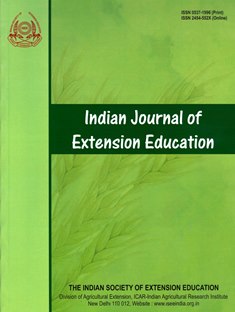Development of Reliability and Validity of Social Cohesiveness Rating Scale (SCRS)
DOI:
https://doi.org/10.48165/IJEE.2023.59129Keywords:
SCRS, EFA, Reliability, Concurrent validityAbstract
Natural Rubber is an important plantation crop and is gaining importance in North Eastern states of India due to increasing demand of rubber nationally and globally. Method of summated rating was administered in the construction of Social Cohesiveness Rating Scale (SCRS). Comprehensive literatures review and experts’ judgements were considered while identifying the item statements of SCRS. The scale was further standardized by establishing uni-dimensionality through administration of Exploratory Factor Analysis (EFA) using Principal Component with Varimax rotation to extract factors. The final scale consisted of 11 items. Spearman rank-order correlation coefficients (rs) on inter-rater reliability of the item statements range from 0.577 to 0.812. High concurrent validity as specified by rs = 0.75 (p < 0.01) signifies a good consideration on the validity of the SCRS to be administered in a research setting.
Downloads
References
Cattell, R. B. (1966). The scree test for the number of factors. Multivariate Behavioral Research, 1, 245–276. http://dx.doi.org/ 10.1207/s15327906mbr0102_10
Churchill Jr, G. A. (1979). A paradigm for developing better measures of marketing constructs. Journal of Marketing Research, 16(1), 64-73.
Costello, A. B., & Osborne, J. W. (2005). Best practices in exploratory factor analysis: Four recommendations for getting the most from your analysis. Practical Assessment, Research and Evaluation, 10, 173-78.
Di-Iorio, C. K. (2005). Measurement in Health Behavior Methods for Research and Education, pp 186, First edition, Jossey-Bass, San Francisco.
Edward, A. L., & Kilpatrick, F. P. (1948). A technique for construction of attitude scales. Journal of Applied Psychology, 32, 374-384.
Edwards, A. L. (1957). Techniques of Attitude Scale Construction. pp. 13. Appleton Century Crofts, Ins, New York.
Floyd, F. J., & Widaman, K. F. (1995). Factor analysis in the development and refinement of clinical assessment instruments. Psychological Assessment, 7(3), 286.
Gupta, S. K., Nain, M. S., Singh, R., & Mishra, J. R. (2022). Development of Scale to Measure Agripreneurs Attitude towards Entrepreneurial Climate. Indian Journal of Extension Education, 58(2), 153–157.
Kaiser, H. F. (1960). The application of electronic computers to factor analysis. Educational and Psychological Measurement, 20, 141–151. http://dx.doi.org/10.1177/001316446002000116
Likert, R. A. (1932). A technique for the measurement of attitude. Archives of Psychology, 22, 5-55.
National Rubber Policy. (2019). Department of Commerce, Government of India. https://commerce.gov.in/hi/wp- content/ uploads/sites/2/2020/02/NTESCL637038876015166279 _National-Rubber-Policy-2019_Hindi.pdf, assessed 2022.
Rubber Board Statistics. (2022). Rubber Board, Ministry of Commerce and Industry, Government of India, Kottayam. http:// rubberboard.org.in/rbfilereader?fileid=730, assessed 2022.
Rubber Board. (2022). Ministry of Commerce and Industry, Government of India, Kottayam. http://rubberboard.org.in/ rbfilereader?fileid=297, assessed 2022.
Singh, D., Kaur, P., & Singh, D. (2021). A standardized scale to measure the attitude of farmers towards zero-till drill. Indian Journal of Extension Education, 57(2), 11-18.
Singh, D., Kaur, P., & Singh, D. (2019). Comparative analysis of psychological characters of farmers adopting various resource conservation technologies. Indian Research Journal of Extension Education, 20(1), 61-66.
Thurstone, L. L., & Chave, E. J. (1929). The measurement of attitude. Chicago University Press, USA. pp 39-40. Wongpakaran, T., Wongpakaran, N., Intachote-Sakamoto, R., & Boripuntakul, T. (2013). The group cohesiveness scale (GCS) for psychiatric inpatients. Perspectives Psychiatric Care, 49, 58-64.
Downloads
Published
Issue
Section
License

This work is licensed under a Creative Commons Attribution-NonCommercial-NoDerivatives 4.0 International License.

